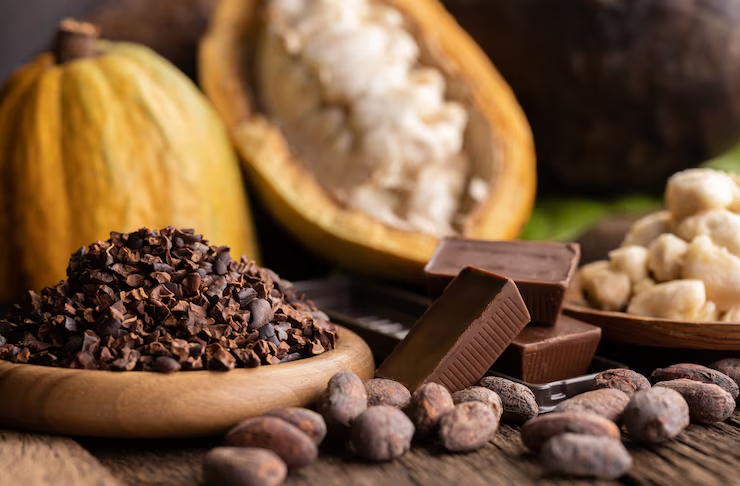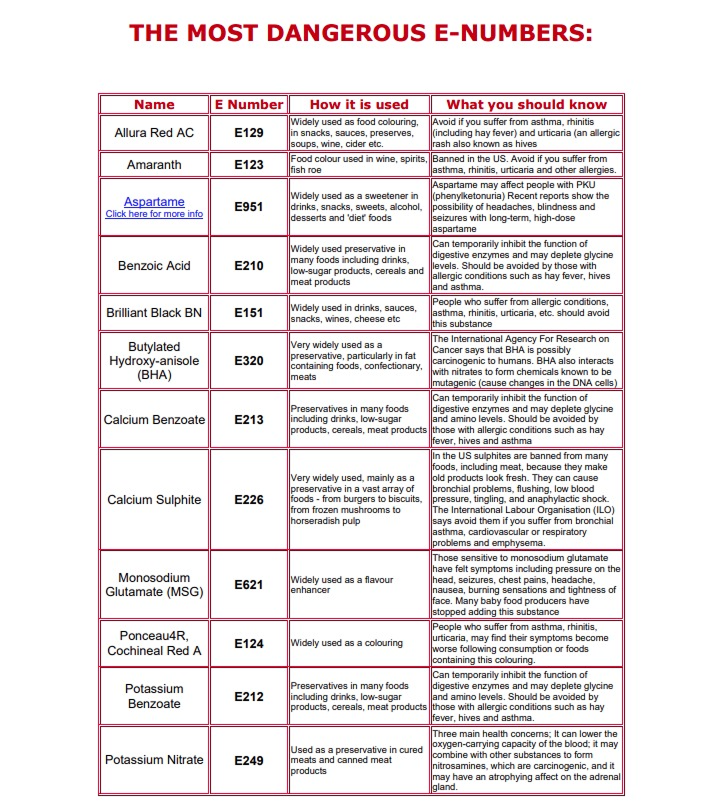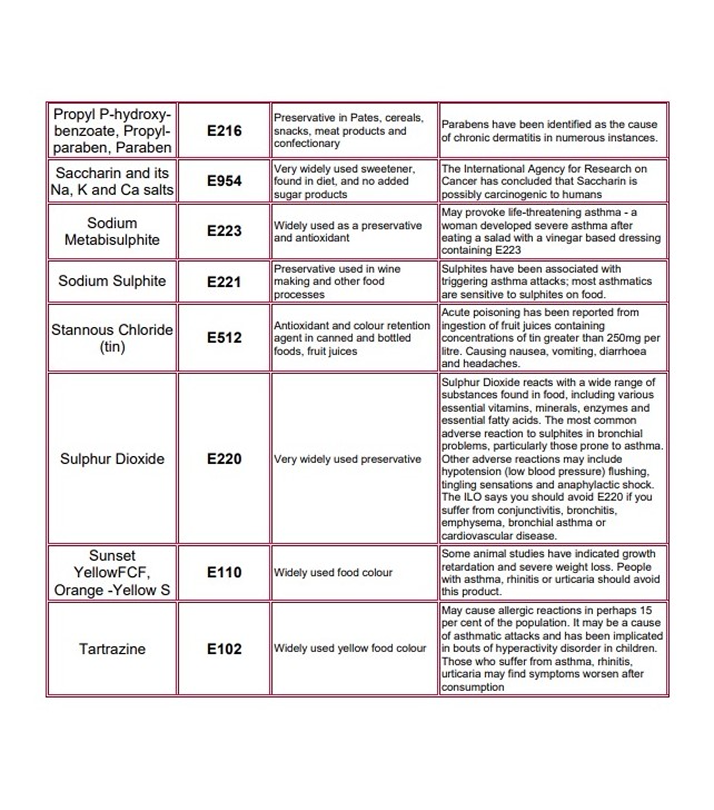
E numbers are codes used to identify food additives in the European Union. They are accepted worldwide, often without the E prefix.
They are used to indicate substances added to food for technological purposes, such as enhancing colour, flavour, texture, or preventing spoilage. Many E numbers represent naturally occurring substances, like vitamin C (E300). The “E” stands for Europe, and the numbers are assigned after rigorous safety testing and approval by the European Food Safety Authority (EFSA).
Many E numbers represent naturally occurring substances, like vitamin C (E300). The “E” stands for Europe, and the numbers are assigned after rigorous safety testing and approval by the European Food Safety Authority (EFSA).
E-Number Categories
| Range | Category |
|---|---|
| E100 - E199 | Colours |
| E200 - E299 | Preservatives |
| E300 - E399 | Antioxidants and acidity regulators |
| E400 - E499 | Thickeners, stabilisers, and emulsifiers |
| E500 - E599 | Acidity regulators and anti-caking agents |
| E600 - E699 | Flavour enhancers |
| E700 - E799 | Antibiotics |
| E900 - E999 | Glazing agents, gases, and sweeteners |
| E1000 - E1599 | Additional additives |
1. E102 – tartrazine. This yellow food colouring has already been banned from use inNorway and Austria, yet it continued being used in food and drinks in the UK. Inrecent years, since a study found it was linked to hyperactivity in children, the UKgovernment have suggested it should be avoided by children, but adults may wellwant to avoid it too. E102 is commonly found in products such as mustard,marmalade, jelly, marzipan, ice lollies, fizzy drinks, squash, custard powder, andsoups.
2. E122 – carmoisine. E122 is a synthetic red dye that’s used as a colouring in manyfoods. Already banned in several countries, including Norway, Japan, America, andInSweden, this colouring is found in products such as sweets, yoghurts, packet soup, jellyand jam. It has been positively linked to hyperactivity in children, and the UKgovernment recommends that children may be better avoiding it, but it can also causeallergic reactions in adults too.
3. E129 – allura red. E129 is a red or orange-like synthetic dye which is used as a foodcolouring in drinks and sweets. As well as being linked to hyperactive behaviour inchildren, it may also cause allergic skin reactions in adults, especially anyonesensitive to aspirin. It’s worth noting that E129 has already been banned in manycountries, including France, Germany, Belgium, Austria, Norway and Sweden.
4. E104 – quinoline yellow. As the name suggests, E104 is a synthetic yellowcolouring and is used in products such as smoked haddock and scotch eggs to providea yellow tinge. Already banned in countries such as Japan, America, Australia andNorway, the colouring has been linked to health and hyperactive problems in children.
5. E621 – monosodium glutamate. Otherwise known as MSG, E621 is a flavourenhancer that’s commonly used to pep up food products and make them taste better.Unfortunately, it is known to cause problems for some people, and certain peopleseem to be more sensitive to its effects than others. Amongst the known side effects,MSG can cause symptoms such as headaches, nausea, dizziness, muscle pain,palpitations and even pain.
6. E951 – aspartame. E951 is an artificial sweetener that’s commonly used as asweetening ingredient. In particular, it’s often found in products aimed at dieters ordiabetics, such as desserts, low-fat foods, low sugar drinks, snacks and sweets. It’swell known to be linked to problems in people who suffer from the condition PKU,and they are well advised to avoid it completely. But aspartame has become a concernto other people too and side effects, such as headaches, have often been reported.
7. E211 – sodium benzoate. E211 is an E number that’s used as a preservative and isfound in products such as margarine, salad dressing, soy sauce, sweets and softdrinks. Studies have found that it’s linked to hyperactivity in children, plus it maycause reactions in people who have allergic conditions or asthma.
8. E151 – black PN / brilliant black BN. E151 is a form of black synthetic dye that isused as a food colouring in some products. However, concerns have been raised inother countries, as it’s been linked to allergic reactions in some people. It is alreadybanned in Australia, Austria, America, Germany, Norway, Sweden, Switzerland,
9. E133 – Brilliant blue FCF. E133 is another synthetic colouring dye, which adds ablue colour to some products. Some people have been found to experience allergicreactions after consuming products containing E133, and this E number is alreadybanned in Austria, Sweden, Switzerland, France, Germany and Norway.
10. E213 – calcium benzoate. E213 is a form of preservative that’s used to lengthenthe shelf life of foods and drinks. It’s often found in low-sugar products, but it hasbeen linked to side effects in people who have allergic conditions.
The Most Dangerous E-Numbers
| Name | E Number | How it is used | What you should know |
|---|---|---|---|
| Allura Red AC | E129 | Widely used as food colouring, in snacks, sauces, preserves, soups, wine, cider etc. | Avoid if you suffer from asthma, rhinitis (including hay fever) and urticaria (an allergic rash also known as hives) |
| Amaranth | E123 | Food colour used in wine, spirits, fish roe | Banned in the US. Avoid if you suffer from asthma, rhinitis, urticaria and other allergies. |
| Aspartame | E951 | Widely used as a sweetener in drinks, snacks, sweets, alcohol, desserts and ‘diet’ foods | Aspartame may affect people with PKU (phenylketonuria). Recent reports show possibility of headaches, blindness and seizures with long-term, high-dose aspartame. |
| Benzoic Acid | E210 | Widely used preservative in processed food including drinks, low-sugar products, cereals and meat products | Can temporarily inhibit the function of digestive enzymes and may deplete glycine levels. Should be avoided by those with conditions such as hay fever, asthma and urticaria. |
| Brilliant Black BN | E151 | Widely used in drinks, sauces, snacks, wines, cheese etc | People who suffer from allergic conditions, asthma, rhinitis, urticaria, etc. should avoid this substance |
| Butylated Hydroxy-anisole (BHA) | E320 | Very widely used as a preservative, particularly in fat containing foods, confectionery, meats | The International Agency For Research on Cancer says that BHA is possibly carcinogenic to humans. BHA also interacts with nitrates to form chemicals known to be mutagenic (cause changes in the DNA cells) |
| Calcium Benzoate | E213 | Preservatives in many foods including drinks, low-sugar products, cereals, meat products | Can temporarily inhibit the function of digestive enzymes and may deplete glycine levels. Should be avoided by those with allergic conditions such as hay fever, hives and asthma |
| Calcium Sulphite | E226 | Very widely used, mainly as a preservative in a vast array of foods - from burgers to biscuits, from frozen mushrooms to horseradish pulp | Can provoke life-threatening asthma attacks and cause gastric irritation, rashes, and anaphylactic shock. Banned in Australia for children's foods. Destroys Vitamin B1. |
| Monosodium Glutamate (MSG) | E621 | Widely used as a flavour enhancer | May cause headaches, chest tightness, nausea, numbness, and asthma attacks in sensitive people. |
| Ponceau 4R, Cochineal Red A | E124 | Widely used as a colouring | Banned in the US. May trigger allergies in people with asthma, rhinitis or urticaria. |
| Potassium Benzoate | E212 | Preservatives in many foods including drinks, low-sugar products, cereals, meat products | Can temporarily inhibit digestive enzymes and reduce glycine levels. Avoid if you have asthma, hay fever, or hives. |
| Potassium Nitrate | E249 | Used as a preservative in cured meats and canned meat products | Can lower blood pressure, affect adrenal glands, and may contribute to cancer development. |
| Propylparaben (Paraben) | E216 | Preservative in pâtés, cereals, snacks, meat products and confectionery | Parabens have been identified as the cause of chronic dermatitis in numerous instances. |
| Saccharin and its Na, K and Ca salts | E954 | Very widely used sweetener found in diet and “no added sugar” products | The International Agency for Research on Cancer has concluded that saccharin is possibly carcinogenic to humans |
| Sodium Metabisulphite | E223 | Widely used as a preservative and antioxidant | May provoke life-threatening asthma – a woman developed severe asthma after eating a salad with a vinegar-based dressing containing E223 |
| Sodium Sulphite | E221 | Preservative used in wine making and other food processes | Sulphites have been associated with triggering asthma attacks; most asthmatics are sensitive to sulphites on food. |
| Stannous Chloride (tin) | E512 | Antioxidant and colour retention agent in canned and bottled foods, fruit juices | Acute poisoning has been reported from ingestion of fruit juices containing concentrations of tin greater than 250 mg per litre. Causing nausea, vomiting, diarrhoea and headaches. |
| Sulphur Dioxide | E220 | Very widely used preservative | Sulphur Dioxide reacts with various substances found in food, including essential vitamins, minerals, enzymes and essential fatty acids. Most common adverse reactions include bronchial issues, hypotension, tingling sensations and even anaphylactic shock. |
| Sunset Yellow FCF | E110 | Widely used food colour | Some animal studies have indicated growth retardation and severe weight loss. People with asthma, rhinitis or urticaria should avoid this product. |
| Tartrazine | E102 | Widely used yellow food colour | May cause allergic reactions in up to 15% of the population. It may be a cause of asthmatic attacks and has been linked to hyperactivity disorder in children. |




